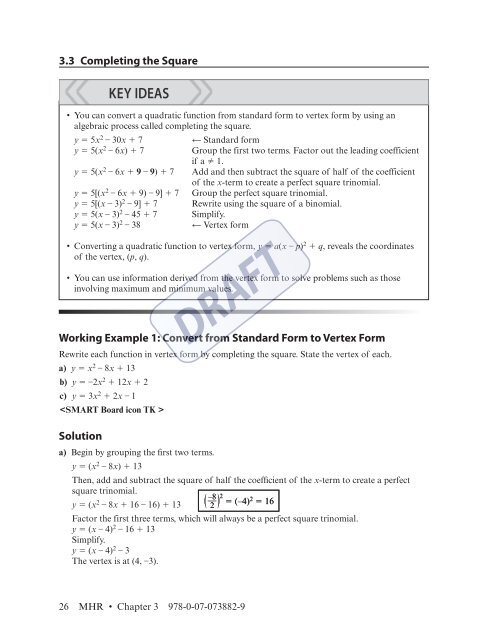Pre-Calculus 11 Workbook - McGraw-Hill Ryerson
Pre-Calculus 11 Workbook - McGraw-Hill Ryerson
Pre-Calculus 11 Workbook - McGraw-Hill Ryerson
- No tags were found...
Create successful ePaper yourself
Turn your PDF publications into a flip-book with our unique Google optimized e-Paper software.
3.3 Completing the SquareKEY IDEAS• You can convert a quadratic function from standard form to vertex form by using analgebraic process called completing the square.y = 5x 2 – 30x + 7y = 5(x 2 – 6x) + 7y = 5(x 2 – 6x + 9 – 9) + 7y = 5[(x 2 – 6x + 9) – 9] + 7y = 5[(x – 3) 2 – 9] + 7y = 5(x – 3) 2 – 45 + 7y = 5(x – 3) 2 – 38← Standard formGroup the first two terms. Factor out the leading coefficientif a ≠ 1.Add and then subtract the square of half of the coefficientof the x-term to create a perfect square trinomial.Group the perfect square trinomial.Rewrite using the square of a binomial.Simplify.← Vertex form• Converting a quadratic function to vertex form, y = a(x – p) 2 + q, reveals the coordinatesof the vertex, (p, q).• You can use information derived from the vertex form to solve problems such as thoseinvolving maximum and minimum values.Working Example 1: Convert from Standard Form to Vertex FormRewrite each function in vertex form by completing the square. State the vertex of each.a) y = x 2 – 8x + 13b) y = –2x 2 + 12x + 2c) y = 3x 2 + 2x – 1Solutiona) Begin by grouping the first two terms.y = (x 2 – 8x) + 13Then, add and subtract the square of half the coefficient of the x-term to create a perfectsquare trinomial.y = (x 2 __– 8x + 16 – 16) + 13( –82 ) 2 = (–4) 2 = 16Factor the first three terms, which will always be a perfect square trinomial.y = (x – 4) 2 – 16 + 13Simplify.y = (x – 4) 2 – 3The vertex is at (4, –3).26 MHR • Chapter 3 978-0-07-073882-9

















